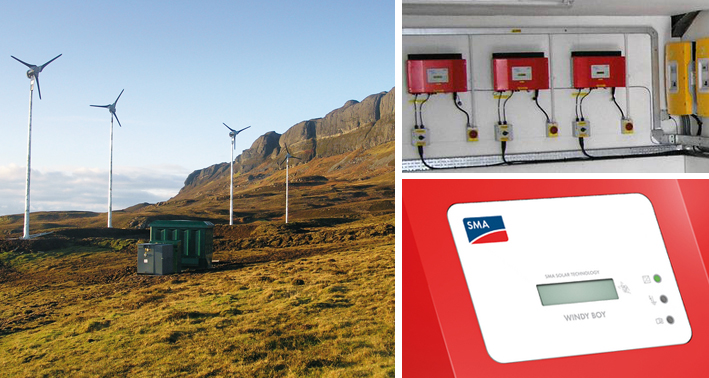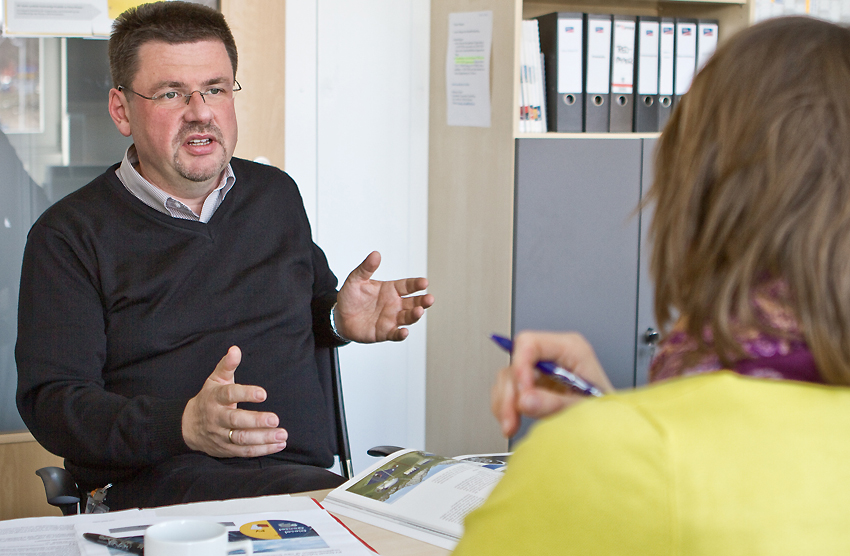SMA to Part Ways with Windy Boy Inverters

SMA will withdraw from the small wind turbine industry at the end of 2013, ceasing all future production of the Windy Boy inverter. We spoke to SMA Executive Vice President Volker Wachenfeld, in the Hybrid Energy Solutions division, about SMA’s decision to end production and how this change will affect the future of new markets.
Volker, what are the reasons for SMA’s withdrawal from the small wind turbine industry?
Due to changes to the political landscape in important sales markets, the demand for small wind turbines has collapsed. For example, the UK government has cut funding for wind power plants below 1.5 kW – the size typically used in domestic applications — making it is simply no longer worthwhile for the customer. In Denmark, the subsidy model has been modified to the point where there are no longer incentives to operate small-scale wind turbines. Since 2010 there has been a clear downturn, and we made the decision to pull out of this business area and discontinue the Windy Boy, Windy Tripower and Windy Boy Protection Box products.
Windy Boy – the inverter for small wind turbine systems – was one of SMA’s first products. Will it hurt a bit to say goodbye?
This has not been an easy decision. As an engineer, I am probably more affected than others by the withdrawal from this area because I am interested in the system technology. It is really gratifying to tailor wind turbine systems to the wind conditions of a specific location. Nevertheless, the bottom line is that these markets must also be lucrative for a company like ours. Times are as tough right now for the renewable energy industry. It makes sense for us to concentrate on business plans for the future. This also means that we have to be resolute in stepping back from business segments that are less promising.
How does this change impact projects that have already been planned with Windy Boy? Depending on the particular site, the approval processes and certification for wind energy systems can take a very long time.
As soon as the decision was made, we informed our affected customers that we would gradually phase out the products throughout the year. This gives our customers the opportunity to stockpile an appropriate supply of inverters and corresponding system technology. Of course we will continue to offer related services.
How did customers react to the news?
Understandably, customers were disappointed. SMA has been the only supplier in this fragile market to offer products tailored for the requirements of small wind turbine systems. The quality we offered was undoubtedly the best in the market segment. However, we also noticed that this market was shifting toward small, more diversified system suppliers all with their own special requirements that inverter manufacturers needed to meet. This environment favors highly specialized electronic start-ups, which have more capacity to fulfill the customers’ very specialized needs than a large-scale manufacturer like us.
You have addressed some important topics for the future. What is on SMA’s agenda?
A really hot topic at the moment is energy management. As the energy industry changes and transitions, we need intelligent solutions to help us employ renewable energy. We are developing solutions for the German market that focus on increased self-consumption. The vision is that photovoltaic systems operators will be able to use as much solar energy generated from their roof as possible for their own consumption. This will help them save on costs associated with buying electricity. On an international level, we see tremendous potential in the area of industrial photovoltaic diesel hybrid systems – meaning that the use of photovoltaics can supplement existing diesel systems. This will allow operators of large-scale systems to save on diesel costs and reduce CO2 emissions.
How do photovoltaics and diesel systems fit together?
They complement each other perfectly. With the addition of solar energy, the power output from diesel systems can be reduced. Most conventional PV systems for rural electrification have an integrated diesel generator that takes over the energy supply when there is little sunlight. In large-scale plants this situation is reversed. Instead of the diesel system supplementing photovoltaic output, PV supplements the diesel. This field combines our core competencies in the areas of off-grid electrification and large-scale PV power plants.
The combination of rising diesel prices and falling prices for PV system technology means that this development is already a commercially attractive alternative for industrial large-scale consumers in off-grid but sun-rich regions. SMA’s first system was installed at the end of 2012 in Thabazimbi, South Africa. Since then, we have been working on PV diesel hybrid projects all around the world – in South Africa, Australia and India, to name a few. Two additional projects have already been sold. Out of approximately 500 gigawatts worldwide of installed power from diesel generators, there’s potential for approximately 50 gigawatts that could benefit from being supplemented with photovoltaics.


I have a nice experience with SMA’s PV-inverter products, my research accomplished by using some sunny boy SB 700 inverter. Currently, I plan to combine the PV inverter and windy boy inverter for my hybrid plant. But, this article signs me to cancel my plan.
We need to get in contact with Michael Stoll. Please send me his email. Thank you
we have got hans on a windmill wirh inverter.
On the inverter there isa lable with the text: Wind Boy Model WB(SB) 1100LV. Serial number 2000596263.
We need a conection diagram?
I would like to know about hybrid charge controller (soar, windmills) ,if the windy boy supplies this product. I need to know technical information about this product such as efficiency, capacity, long life, price, etc….
I will like to buy a 2kw wind dy boy inverter for wind turbine. thank you
Hi Windmill fans,
Don’t despair at the Windy Boy loss, a solution is at hand !! It works very well !! Look at my plant profile on Sunny Portal: http://www.sunnyportal.com/FixedPages/PlantProfile.aspx. This solution would work for small, one turbine systems or many turbine systems. I would be glad to share the design with you. Its been three years in development! And the SMA standard Sunny Boy inverters are the key. No charge controllers / diverters needed! I am an Electrical Engineer and integration of solar and wind has been a “wind-fall”….lol !
Michael Stoll
Cedarville, Michigan and Bristol, Indiana